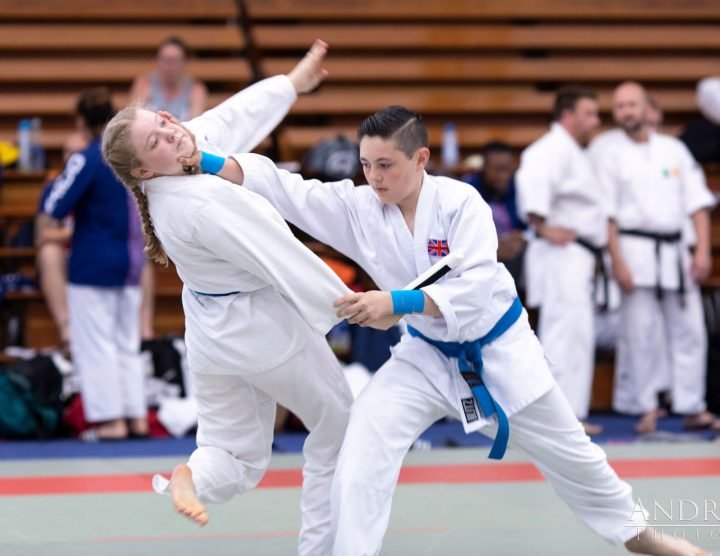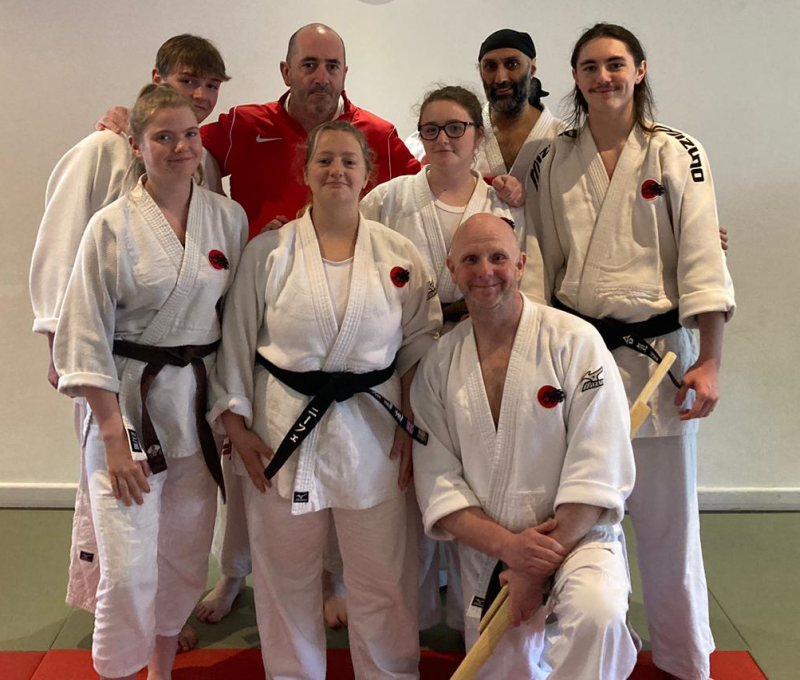These are answers to some questions you may have about taking part in an Aikido training session. If your question isn’t covered here, then either use our contact us form or alternatively come to one of the club training sessions and speak to one of the club coaches.
Please ensure that you inform one of the club coaches if you are taking any medication or have any injuries.
What should I wear?

To start you can wear any loose fitting clothing such as track suit bottoms and a T-shirt, but if you already have a white Gi/Keikogi/Gogi (derived from keiko means practice, gi means dress or clothes) – this should be worn. After a a few weeks you can order a Gi from the club.
Long hair should be tied back and all jewellery removed.
Flip-flops should be worn from the changing room to the edge of the mat as you will train barefoot. By not wearing outdoor shoes, this prevents dust and dirt from being brought onto the Dojo mats.
Bring a bottle of water to each session. This is because it’s important to drink water during exercise.
Dojo Etiquette
Although we train in a sports hall, the Japanese term for a training room is Dojo. The Dojo floor is covered with rubber mats.
There are a number of points when practicing Aikido where it is customary to “bow”. In Japan, bows are a done as both a greeting and an expression of thanks. Therefore, Aikidoka bow as a greeting before practicing an Aikido technique and again after practice to thank their training partner.
The points were a bow is expected are:
- As you leave the Dojo;
- As you leave the Dojo;
- As you join the mats;
- As you leave the mats;
- As you start to practice an Aikido technique with your training partner;
- After practicing the Aikido technique with your training partner.
If the training session is already in progress, you should kneel and wait at the edge of the mat to invited to join by the coach.
One of our favourite none Aikido YouTube channels discussing dojo etiquette. Whilst this is Karate there is very little difference in Aikido.
What’s the structure of a typical Aikido class?
This is an outline of a typical Aikido training class, which typically lasts about one and a half hours.
- Warm-up;
- Ukemi practice – Backward break fall, Forward/Backward roll, Rolling break fall;
- Unsoku – foot movement exercise;
- Tandoku-undo – Hand and foot movement exercise;
- Aikido techniques – which could be from a Kata, free practice or preparation for competition.
Some Aikido techniques use joint locks and so you will feel some discomfort as the lock is applied. If the pain of the lock gets too much for you, you should slap your thigh with your hand (if standing) or slap the mat (if lying on the Dojo mats) and your training partner will slacken the hold.
Aikidoka as training partner
In Aikido you train with another Aikidoka who is your training partner, NOT an opponent. Your training partner allows you to use their body so that you can learn the Aikido technique and they trust you to not take advantage and hurt them.
Don’t forget this because you’ll swap roles and you’ll be on the receiving end of the technique!
How do I get my black belt?

Bradford Tomiki Aikido Club, as a member of the British Aikido Association (BAA) follows the BAA grading syllabus.
For seniors, the starting grade is 7th Kyu (“red” belt). To gain promotion to subsequent grades or belts (white, yellow, green etc.) and be promoted to a Dan grade (black belt), you will need to pass a grading where you will demonstrate the required number of techniques for the grade to the required standard.
With each grade, the number of techniques to demonstrate increases.
- 6th Kyu (white belt) requires 5 techniques from the Randori-no-kata to be demonstrated;
- 4th Kyu (orange belt) requires 14 techniques from the Randori-no-kata to be demonstrated;
- 2nd Kyu (blue belt) requires:
- all 17 techniques from the Randori-no-kata
- all 10 techniques from the Randori-no-kata-no-ura-waza
- all 7 techniques from Shichi-hon-no-kuzushi
- 1st Dan requires:
- all 17 techniques from the Randori-no-kata
- all 10 techniques from the Randori-no-kata-no-ura-waza
- 14 techniques from the Koryu dai Yon
- 24 techniques from the Koryu dai San
The BAA grading syllabus places an equal emphasis on Embu (Kata) and the application of the Kata techniques in the form of Kakarigeiko, Hikitategeiko and Toshu. You will need to pass both the kata and the application sections to pass a grading.
The BAA does not recognise the award of a Dan grade to young people under the age of 17 years.
This is a summary of the BAA grading syllabus.
